Detection and Prediction of the Early Thermal Runaway and Control of the Li-Ion Battery by the Embedded Temperature Sensor Array
Abstract
:1. Introduction
2. Materials and Methods
2.1. Ceramics Preparation
2.2. Sensor Preparation
2.3. Measurement and Characterization
3. Results and Discussion
3.1. PTCR Properties
3.1.1. Ceramics
3.1.2. Temperature Sensor Array
3.2. Static Measurement Inside the Battery
3.3. Dynamic Measurement Inside the Battery
4. Conclusions
Author Contributions
Funding
Institutional Review Board Statement
Informed Consent Statement
Data Availability Statement
Acknowledgments
Conflicts of Interest
References
- Xu, B.; Lee, J.; Kwon, D.; Kong, L.; Pecht, M. Mitigation strategies for Li-ion battery thermal runaway: A review. Renew. Sustain. Energy Rev. 2021, 150, 111437. [Google Scholar] [CrossRef]
- Huang, L.; Liu, L.; Lu, L.; Feng, X.; Han, X.; Li, W.; Zhang, M.; Li, D.; Liu, X.; Sauer, D.U. A review of the internal short circuit mechanism in lithium-ion batteries: Inducement, detection and prevention. Int. J. Energy Res. 2021, 45, 15797–15831. [Google Scholar] [CrossRef]
- Sebastian, R. A review of fire mitigation methods for li-ion battery energy storage system. Process Saf. Prog. 2022, 41, 426–429. [Google Scholar] [CrossRef]
- Wen, J.; Yu, Y.; Chen, C. A review on lithium-ion batteries safety issues: Existing problems and possible solutions. Mater. Express 2012, 2, 197–212. [Google Scholar] [CrossRef]
- Wang, Q.; Mao, B.; Stoliarov, S.I.; Sun, J. A review of lithium ion battery failure mechanisms and fire prevention strategies. Prog. Energy Combust. Sci. 2019, 73, 95–131. [Google Scholar] [CrossRef]
- Feng, X.; Ouyang, M.; Liu, X.; Lu, L.; Xia, Y.; He, X. Thermal runaway mechanism of lithium ion battery for electric vehicles: A review. Energy Storage Mater. 2018, 10, 246–267. [Google Scholar] [CrossRef]
- Feng, X.; Ren, D.; He, X.; Ouyang, M. Mitigating thermal runaway of lithium-ion batteries. Joule 2020, 4, 743–770. [Google Scholar] [CrossRef]
- Chen, Y.; Kang, Y.; Zhao, Y.; Wang, L.; Liu, J.; Li, Y.; Liang, Z.; He, X.; Li, X.; Tavajohi, N. A review of lithium-ion battery safety concerns: The issues, strategies, and testing standards. J. Energy Chem. 2021, 59, 83–99. [Google Scholar] [CrossRef]
- Xiao, Y.; Fu, A.; Zou, Y.; Huang, L.; Wang, H.; Su, Y.; Zheng, J. High safety lithium-ion battery enabled by a thermal-induced shutdown separator. Chem. Eng. J. 2022, 438, 135550. [Google Scholar] [CrossRef]
- Huai, Y.; Gao, J.; Deng, Z.; Suo, J. Preparation and characterization of a special structural poly (acrylonitrile)-based microporous membrane for lithium-ion batteries. Ionics 2010, 16, 603–611. [Google Scholar] [CrossRef]
- Li, J.; Zhang, Y.; Shang, R.; Cheng, C.; Cheng, Y.; Xing, J.; Wei, Z.; Zhao, Y. Recent advances in lithium-ion battery separators with reversible/irreversible thermal shutdown capability. Energy Storage Mater. 2021, 43, 143–157. [Google Scholar] [CrossRef]
- Ji, W.; Jiang, B.; Ai, F.; Yang, H.; Ai, X. Temperature-responsive microspheres-coated separator for thermal shutdown protection of lithium ion batteries. RSC Adv. 2015, 5, 172–176. [Google Scholar] [CrossRef]
- Koch, S.; Birke, K.P.; Kuhn, R. Fast thermal runaway detection for lithium-ion cells in large scale traction batteries. Batteries 2018, 4, 16. [Google Scholar] [CrossRef]
- Feng, X.; Sun, J.; Ouyang, M.; Wang, F.; He, X.; Lu, L.; Peng, H. Characterization of penetration induced thermal runaway propagation process within a large format lithium ion battery module. J. Power Sources 2015, 275, 261–273. [Google Scholar] [CrossRef]
- Liu, P.; Liu, C.; Yang, K.; Zhang, M.; Gao, F.; Mao, B.; Li, H.; Duan, Q.; Wang, Q. Thermal runaway and fire behaviors of lithium iron phosphate battery induced by over heating. J. Energy Storage 2020, 31, 101714. [Google Scholar] [CrossRef]
- Raijmakers, L.; Danilov, D.; Eichel, R.-A.; Notten, P. A review on various temperature-indication methods for Li-ion batteries. Appl. Energy 2019, 240, 918–945. [Google Scholar] [CrossRef]
- Matuck, L.C.; Cabrita, P.D.; Pinto, J.L.; Marques, C.A.; Nascimento, M.S. Customized Optical Fiber Birefringent Sensors to Multipoint and Simultaneous Temperature and Radial Strain Tracking of Lithium-Ion Batteries. Adv. Sens. Res. 2023, 2200046. [Google Scholar] [CrossRef]
- Lu, L.; Han, X.; Li, J.; Hua, J.; Ouyang, M. A review on the key issues for lithium-ion battery management in electric vehicles. J. Power Sources 2013, 226, 272–288. [Google Scholar] [CrossRef]
- Biazi, V.; Moreira, A.C.; Pinto, J.L.; Nascimento, M.; Marques, C. A particle filter-based virtual sensor for estimating the state of charge and internal temperature of lithium-ion batteries: Implementation in a simulated study case. J. Energy Storage 2023, 61, 106814. [Google Scholar] [CrossRef]
- Bell, J.G.; Graule, T.; Stuer, M. Barium titanate-based thermistors: Past achievements, state of the art, and future perspectives. Appl. Phys. Rev. 2021, 8, 031318. [Google Scholar] [CrossRef]
- Feng, X.; Ai, X.; Yang, H. A positive-temperature-coefficient electrode with thermal cut-off mechanism for use in rechargeable lithium batteries. Electrochem. Commun. 2004, 6, 1021–1024. [Google Scholar] [CrossRef]
- Xia, L.; Li, S.-L.; Ai, X.-P.; Yang, H.-X.; Cao, Y.-L. Temperature-sensitive cathode materials for safer lithium-ion batteries. Energy Environ. Sci. 2011, 4, 2845–2848. [Google Scholar] [CrossRef]
- Ji, W.; Wang, F.; Liu, D.; Qian, J.; Cao, Y.; Chen, Z.; Yang, H.; Ai, X. Building thermally stable Li-ion batteries using a temperature-responsive cathode. J. Mater. Chem. A 2016, 4, 11239–11246. [Google Scholar] [CrossRef]
- Li, H.; Wang, F.; Zhang, C.; Ji, W.; Qian, J.; Cao, Y.; Yang, H.; Ai, X. A temperature-sensitive poly (3-octylpyrrole)/carbon composite as a conductive matrix of cathodes for building safer Li-ion batteries. Energy Storage Mater. 2019, 17, 275–283. [Google Scholar] [CrossRef]
- Li, H.; Zhang, X.; Zhang, C.; Cao, Y.; Yang, H.; Ai, X.; Zhong, F. Building a Thermal Shutdown Cathode for Li-Ion Batteries Using Temperature-Responsive Poly (3-Dodecylthiophene). Energy Technol. 2020, 8, 2000365. [Google Scholar] [CrossRef]
- Kise, M.; Yoshioka, S.; Hamano, K.; Takemura, D.; Nishimura, T.; Urushibata, H.; Yoshiyasu, H. Development of new safe electrode for lithium rechargeable battery. J. Power Sources 2005, 146, 775–778. [Google Scholar] [CrossRef]
- Zhong, H.; Kong, C.; Zhan, H.; Zhan, C.; Zhou, Y. Safe positive temperature coefficient composite cathode for lithium ion battery. J. Power Sources 2012, 216, 273–280. [Google Scholar] [CrossRef]
- Li, J.; Chen, J.; Lu, H.; Jia, M.; Jiang, L.; Lai, Y.; Zhang, Z. A positive-temperature-coefficient layer based on Ni-mixed poly (vinylidene fluoride) composites for LiFePO4 electrode. Int. J. Electrochem. Sci. 2013, 8, 5223–5231. [Google Scholar]
- Ren, D.; Feng, X.; Liu, L.; Hsu, H.; Lu, L.; Wang, L.; He, X.; Ouyang, M. Investigating the relationship between internal short circuit and thermal runaway of lithium-ion batteries under thermal abuse condition. Energy Storage Mater. 2021, 34, 563–573. [Google Scholar] [CrossRef]
- Guo, G.; Long, B.; Cheng, B.; Zhou, S.; Xu, P.; Cao, B. Three-dimensional thermal finite element modeling of lithium-ion battery in thermal abuse application. J. Power Sources 2010, 195, 2393–2398. [Google Scholar] [CrossRef]
- Bhadrakumari, S.; Predeep, P. YBa2Cu3O7-x/Thermoplastic polymer composite thermistors. Eur. Polym. J. 2009, 45, 226–229. [Google Scholar] [CrossRef]
- Chen, L.; Zhang, J. Designs of conductive polymer composites with exceptional reproducibility of positive temperature coefficient effect: A review. J. Appl. Polym. Sci. 2021, 138, 49677. [Google Scholar] [CrossRef]
- Chen, Y.; Yang, S. PTCR effect in donor doped barium titanate: Review of compositions, microstructures, processing and properties. Adv. Appl. Ceram. 2011, 110, 257–269. [Google Scholar] [CrossRef]
- Zhao, L.; Watanabe, I.; Doi, T.; Okada, S.; Yamaki, J.-I. TG-MS analysis of solid electrolyte interphase (SEI) on graphite negative-electrode in lithium-ion batteries. J. Power Sources 2006, 161, 1275–1280. [Google Scholar] [CrossRef]
- Aurbach, D.; Zaban, A.; Ein-Eli, Y.; Weissman, I.; Chusid, O.; Markovsky, B.; Levi, M.; Levi, E.; Schechter, A.; Granot, E. Recent studies on the correlation between surface chemistry, morphology, three-dimensional structures and performance of Li and Li-C intercalation anodes in several important electrolyte systems. J. Power Sources 1997, 68, 91–98. [Google Scholar] [CrossRef]
- Richard, M.; Dahn, J. Accelerating rate calorimetry study on the thermal stability of lithium intercalated graphite in electrolyte. I. Experimental. J. Electrochem. Soc. 1999, 146, 2068. [Google Scholar] [CrossRef]
- Yang, H.; Bang, H.; Amine, K.; Prakash, J. Investigations of the exothermic reactions of natural graphite anode for Li-ion batteries during thermal runaway. J. Electrochem. Soc. 2004, 152, A73. [Google Scholar] [CrossRef]
- Wang, Q.; Sun, J.; Yao, X.; Chen, C. Thermal behavior of lithiated graphite with electrolyte in lithium-ion batteries. J. Electrochem. Soc. 2005, 153, A329. [Google Scholar] [CrossRef]
- Duh, Y.-S.; Theng, J.-H.; Chen, C.-C.; Kao, C.-S. Comparative study on thermal runaway of commercial 14,500, 18,650 and 26,650 LiFePO4 batteries used in electric vehicles. J. Energy Storage 2020, 31, 101580. [Google Scholar] [CrossRef]
- Feng, X.; Fang, M.; He, X.; Ouyang, M.; Lu, L.; Wang, H.; Zhang, M. Thermal runaway features of large format prismatic lithium ion battery using extended volume accelerating rate calorimetry. J. Power Sources 2014, 255, 294–301. [Google Scholar] [CrossRef]
- Zou, K.; Lu, S.; Chen, X.; Gao, E.; Cao, Y.; Bi, Y. Thermal and gas characteristics of large-format LiNi0.8Co0.1Mn0.1O2 pouch power cell during thermal runaway. J. Energy Storage 2021, 39, 102609. [Google Scholar] [CrossRef]
- Huang, L.; Zhang, Z.; Wang, Z.; Zhang, L.; Zhu, X.; Dorrell, D.D. Thermal runaway behavior during overcharge for large-format Lithium-ion batteries with different packaging patterns. J. Energy Storage 2019, 25, 100811. [Google Scholar] [CrossRef]

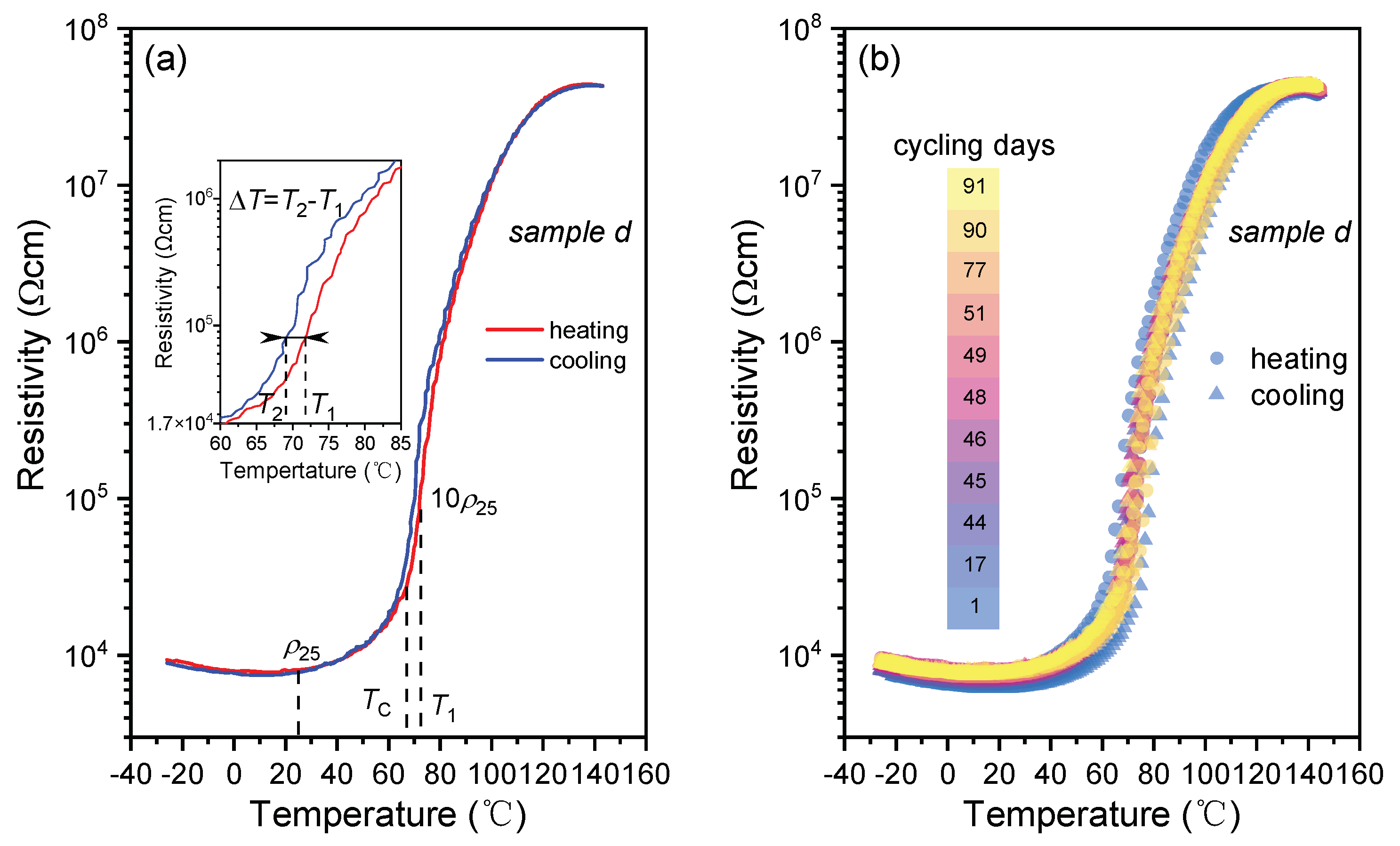
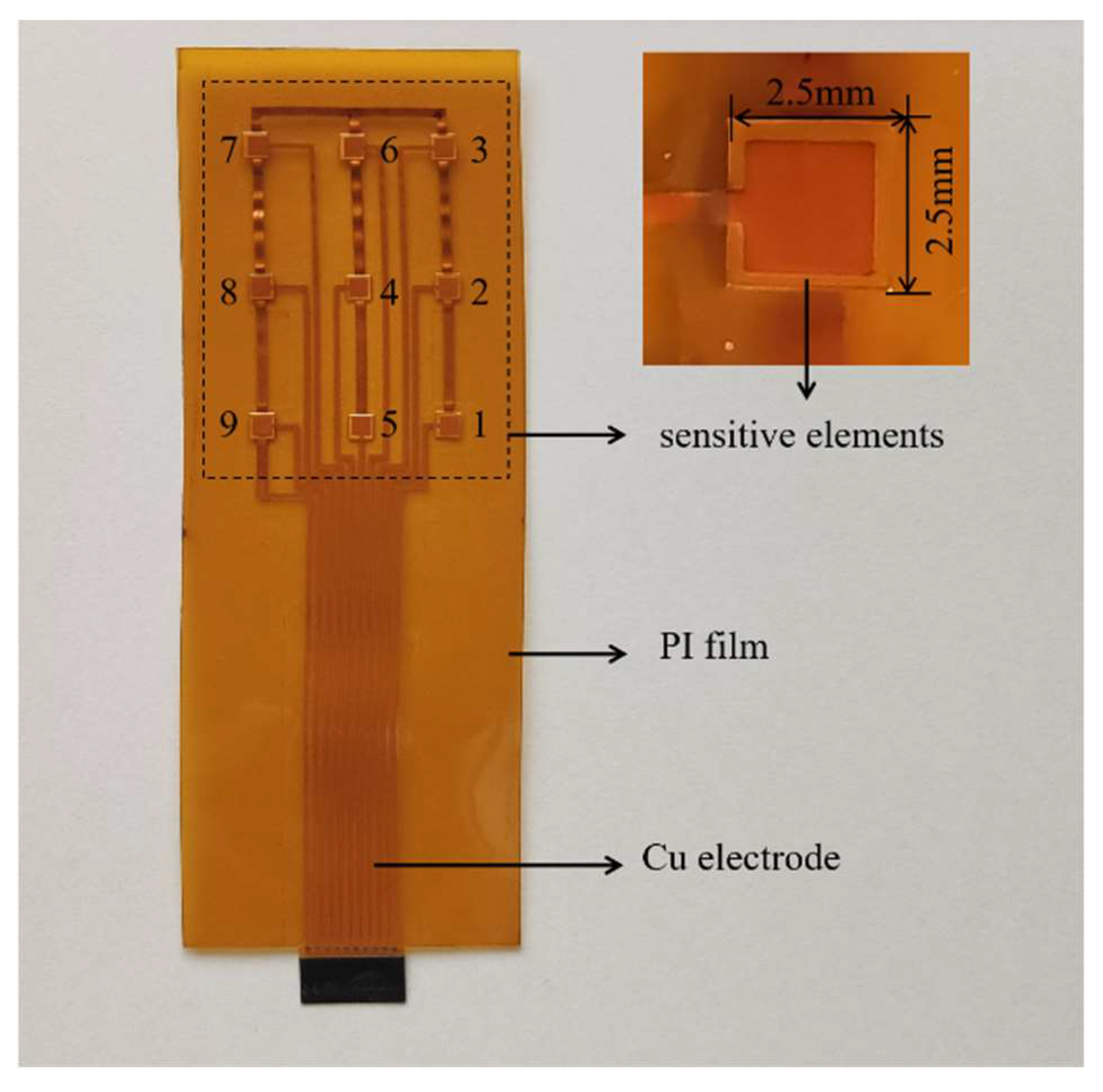


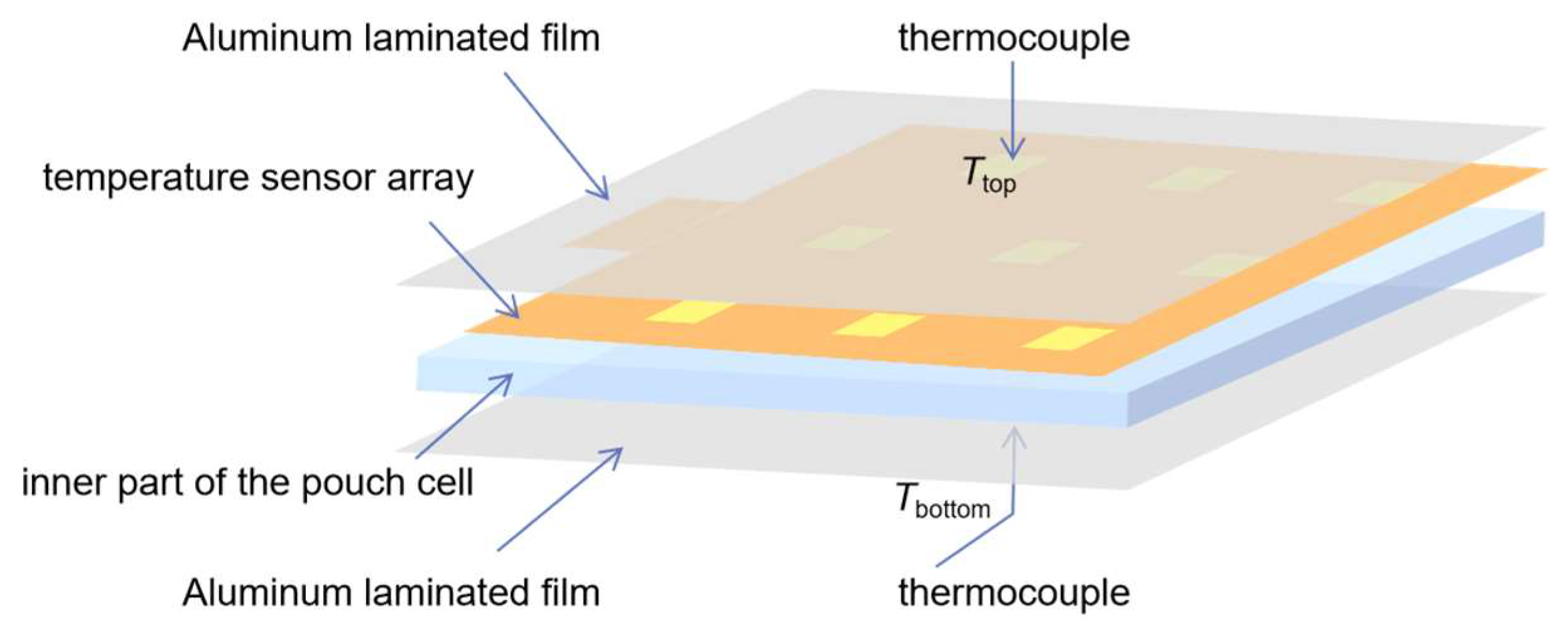
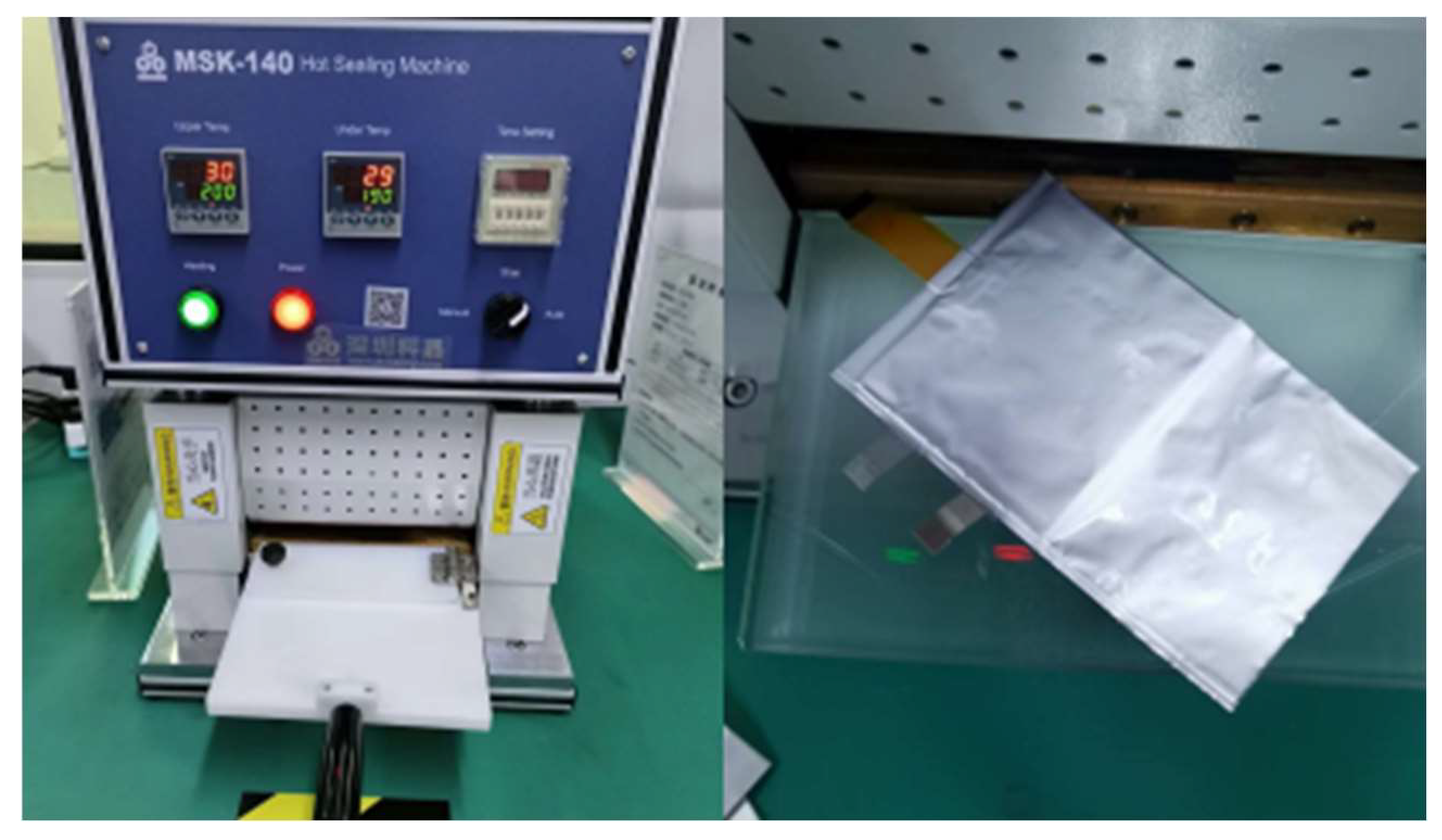
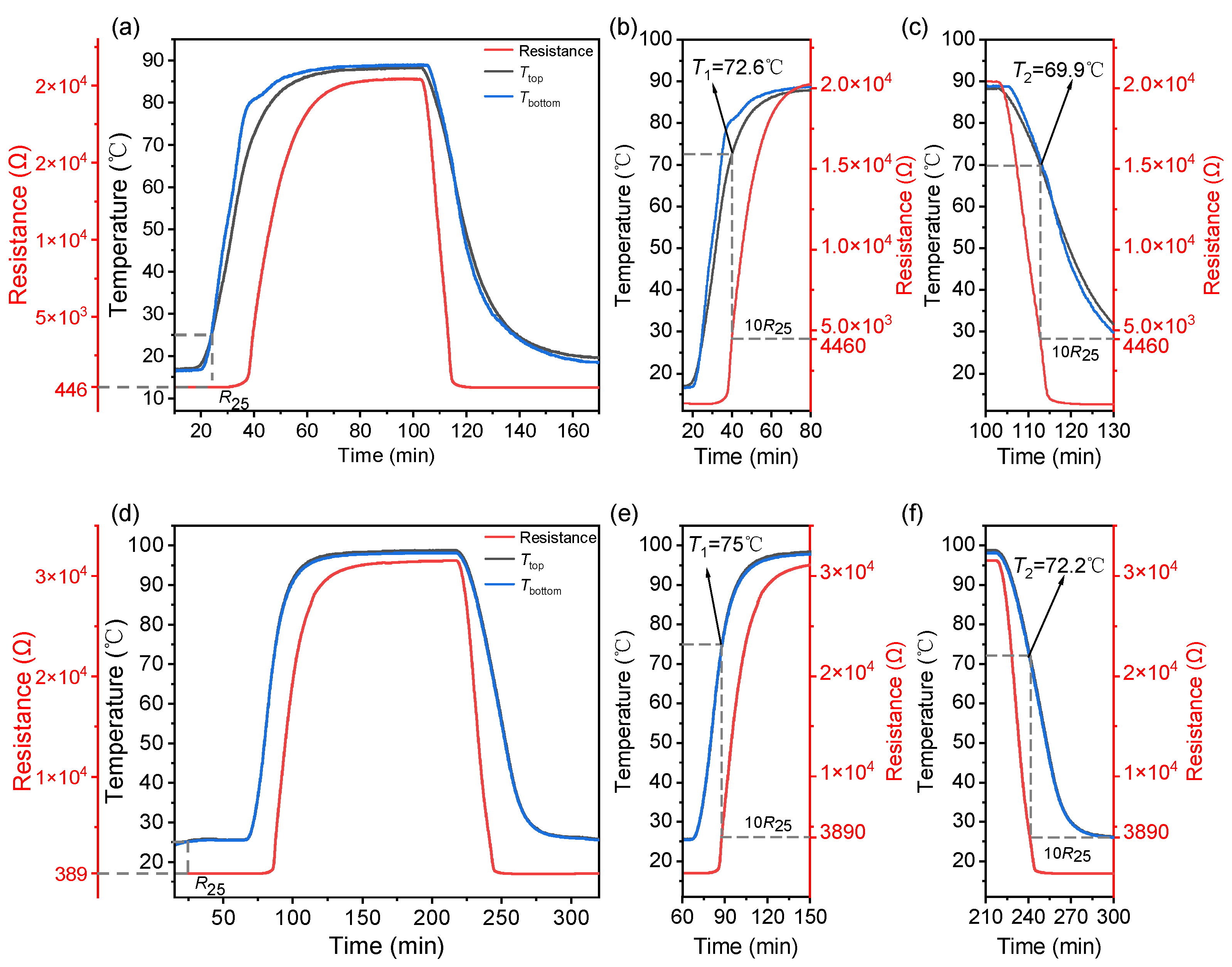

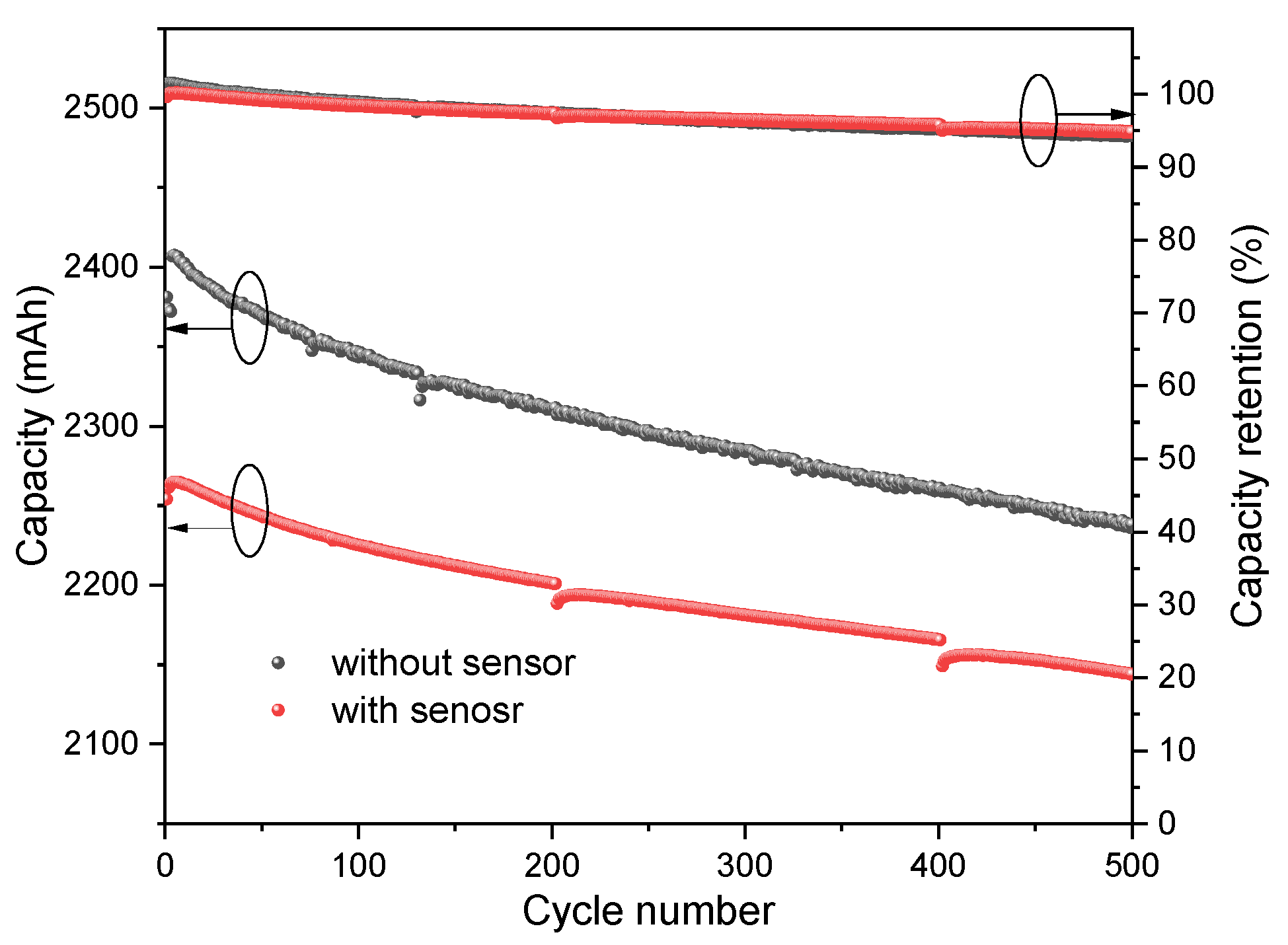
| Sample | ρ25 (Ωcm) | Tc (°C) | T1 (°C) | ΔT (°C) |
|---|---|---|---|---|
| a | 2.3 × 105 | 70 | 80.1 | −7.6 |
| b | 8.9 × 105 | 80 | 88.6 | −20.4 |
| c | 1.4 × 106 | 90 | 94.4 | −6.7 |
| d | 8.1 × 103 | 67 | 71.9 | −3.3 |
| Test Batteries | Capacity | SOC | Thermal Runaway Triggers | Temperature Rise Rate | |
|---|---|---|---|---|---|
| Pouch cell [29] | 24 Ah | 100% | Thermal abuse | <0.01 °C/min (T<~70 °C) <1 °C/s (~70 °C < T< ~210 °C) | |
| Cylindrical cell [39] | 14,500: 900 mAh; 18,650: 1100 mAh; 26,650: 2500 mAh; 26,650: 3000 mAh | 100% | Thermal abuse | ≤~1 °C/min (T < 100 °C) | |
| Prismatic cell [40] | 25 Ah | 100% | Thermal abuse | ≤0.1 °C/min (50 °C < T < 150 °C) | |
| Pouch cell [41] | 7800 mAh | 100% | Thermal abuse | <0.02 °C/min (T < ~84.17 °C) <1 °C/min (~84.17–35.88 °C) | |
| Prismatic cell, Pouch cell [42] | 40 Ah (both) | prismatic cell: 148% pouch cell: 154.6% | Electrical abuse | Prismatic cell: ~5.8 °C/min (74–99 °C) | Pouch cell: ~11.2 °C/min (55–93 °C) |
| Cylindrical cell [17] | 3200 mAh | - | Electrical abuse | ~1.1 °C/min (~20 °C < T< ~60 °C) | |
| Environment Temperature | 55 °C | 60 °C | ||
|---|---|---|---|---|
| Process | 2C Charging | 2C Discharging | 2.5C Charging | 2.5C Discharging |
| Tmax (°C) | 63.7 | 63.3 | 70.2 | 69.3 |
| Rmax (×103 Ω) | 0.86 | 0.82 | 3.03 | 2.22 |
Disclaimer/Publisher’s Note: The statements, opinions and data contained in all publications are solely those of the individual author(s) and contributor(s) and not of MDPI and/or the editor(s). MDPI and/or the editor(s) disclaim responsibility for any injury to people or property resulting from any ideas, methods, instructions or products referred to in the content. |
© 2023 by the authors. Licensee MDPI, Basel, Switzerland. This article is an open access article distributed under the terms and conditions of the Creative Commons Attribution (CC BY) license (https://creativecommons.org/licenses/by/4.0/).
Share and Cite
Zhang, H.; Zhang, X.; Wang, W.; Yu, P. Detection and Prediction of the Early Thermal Runaway and Control of the Li-Ion Battery by the Embedded Temperature Sensor Array. Sensors 2023, 23, 5049. https://doi.org/10.3390/s23115049
Zhang H, Zhang X, Wang W, Yu P. Detection and Prediction of the Early Thermal Runaway and Control of the Li-Ion Battery by the Embedded Temperature Sensor Array. Sensors. 2023; 23(11):5049. https://doi.org/10.3390/s23115049
Chicago/Turabian StyleZhang, Hengyi, Xiaoshan Zhang, Wenwu Wang, and Ping Yu. 2023. "Detection and Prediction of the Early Thermal Runaway and Control of the Li-Ion Battery by the Embedded Temperature Sensor Array" Sensors 23, no. 11: 5049. https://doi.org/10.3390/s23115049
APA StyleZhang, H., Zhang, X., Wang, W., & Yu, P. (2023). Detection and Prediction of the Early Thermal Runaway and Control of the Li-Ion Battery by the Embedded Temperature Sensor Array. Sensors, 23(11), 5049. https://doi.org/10.3390/s23115049






